New Zealand
In the land of the long white cloud (March - April 2014) - map
Unfortunately, James Cook discovered New Zealand about 200 years earlier than would be appropriate. One of the most beautiful countries in the world is today almost destroyed by the greed of our civilization. On the other hand, it should be noticed that efforts to return the country at least partially to its original state are the world's premium. Travelling in New Zealand is comfortable - there's nothing that can eat or even bite you, and the infrastructure is adapted to tourists. I just have to get used to the fact that everything here is vice versa: the sun shines from the north, the south is colder, they drive on the left, Christmas is in the summer and if someone steals, he goes to the jail. New Zealand consists of two main islands, of which the southern one is bigger, better preserved and apparently far more beautiful. Therefore, it becomes my primary goal.
Way to south
After landing in New Zealand everything looks so cute. I feel as if I come to grandma's for the holidays. Everything around me is small and homelike, and nobody is in a hurry. Just like at the real end of the world. Later that evening, in Auckland downtown, I quickly sober up. After Southeast Asia, this is a brutal price shock. I enter the store to buy something to eat. Even the smallest bullshit costs my week salary at home. I turn to the salesman with tears saying that everything is too expensive for me. So turn back and get out, answers he politely. I have no idea, how to survive six weeks here without a mortgage. The hostel in the centre I booked before arrival to have a rest after a long flight is full of golden youth from Australia, who tweets nonstop everywhere around me. An hour of internet connection costs same as dinner in a good restaurant at home. Still sleepy I get out next morning and go hitchhiking out of town. I do not have a map, so I start right in the centre. After two hours, a gracious and friendly guy originally from Fiji takes me away. Although the sky is completely overcast and I just came from Southeast Asia, in the early afternoon I realize that my hands and neck are completely burnt. Oh, I see, so the ozone hole actually exists. Hitchhiking does not work very well, I'm heading south confusedly and the first day the distance is only 250 kilometres. Besides, most geographic names are taken from the original Maori language, and they all sound somewhat like Huatamatawepehepe, so I get consistently lost. My first target is Tongariro National Park, which was established as a buffer zone around one of the volcanoes on the North Island. After two days and eighteen cars, I arrive at the entrance gate.
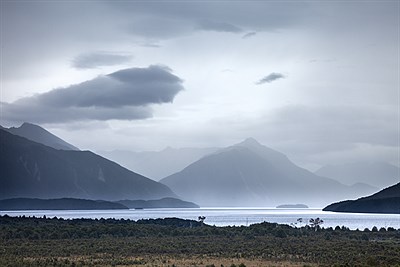
Although New Zealand is famous for hundreds of fascinating trekking routes, there are seven of those, so-called Great Walks, which stand above all others (same as the One Ring). Everybody wants to experience them, so the government created a registration system with daily quotas for those treks. The most famous one, Milford Sound Trek is booked almost a year in advance. Tongariro crossing, which I plan to undertake is also one of the Great Walks, but can be done without registration unless you want to sleep in the huts along the route. Almost immediately after the first hundred metres, I feel like being in the real wilderness, surrounded by beautiful landscape with no signs of civilization. I build my tent and realize, that I'm in nature for the first time since I left home, there is no chance to see the wilderness in the Southeast Asia. In the morning, the weather deteriorates and the wind becomes stronger. I join the main tourist route, and I continue in the endless snake of people. The wind raises and becomes a bit dangerous. I meet several girls on the verge of collapse. Oh, I see, so the wind can be really strong in New Zealand. After crossing the ridge in the mist I quit the main route and continue the solo trek. The landscape looks little extraterrestrial, and the terrain is covered with colourful sands and lakes with volcanic activity. It takes me exactly 24 hours to finish the route planned for three days, half dead I lie down on the road leading further south.
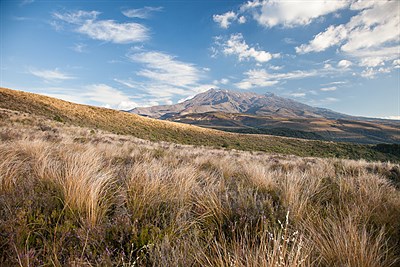
I'm lucky. The very first car takes me to the southern tip of the North Island to Wellington. The guy offers me an overnight sleep in his house, but after a short phone conversation with his wife, he cancels his proposals. I build my tent in the car park outside the city, and the next morning I load my backpack on a ferry which shuttles between islands. Arriving on the South Island gives the impression that I can expect a real natural jewel. We sail through the shallow fjords Marlborough Sounds and we land in a village called Picton.
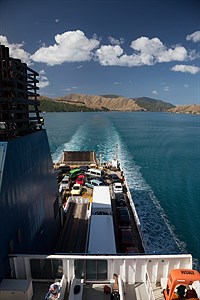
Abel Tasman
Almost exhausted, I check into the hostel in Nelson and I decide to have one day off. I realize that I constantly move for more than two weeks. Nelson seems like a perfect place for living until I meet two teenage girls in the central park. They mention their hometown as “the dirty hole where absolutely nothing happens the whole year round.” The next morning I set out on a trek along the coast called Abel Tasman Great Walk. It is the most popular trek in the country and registration is required for overnight camping. This time, I risk the visit without annoying paperwork. The trek is very pleasant and comfortable. The trail meanders almost invariably in a beautiful rich woods within rare sights of natural sandy beaches.
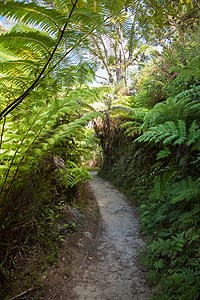
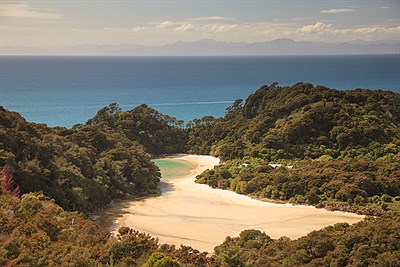
End of the World
The next night I am experiencing the local flies attack for the first time. The so-called sandflies are the only inconvenience in this country, yet sometimes, one would perhaps prefer a grizzly bear attack. They encircle my tent with such intensity that I start to seriously consider buying a portable toilet, to be able to pee inside. I arrive by hitchhiking to the largest city in the South Island. Christchurch was twice severely damaged during an earthquake. I booked car here a few days ago. The gentleman behind the counter changes the agreed terms right in front of my eyes: the car costs more, and I cannot go with it to the North Island. Even so, I pay less than half of the usual price. The first day is full of nervousness - driving on the left, heavy rains and quite a busy road is not a right combination. I drive to the famous Moeraki Boulders, geological oddities of the Paleocene. Evening shooting sucks while I'm pretty lucky in the morning. I keep the direction to the south, and it is almost deserted. Travelling by car is more comfortable than hitchhiking, especially when it's raining almost constantly. On the southern coast of the ocean, I experience a real photographic nirvana: the clouds move in three independent layers, the sea storms and on the west in the mountains Fiordland I see several snowstorms. The most fascinating game of light I've ever seen.
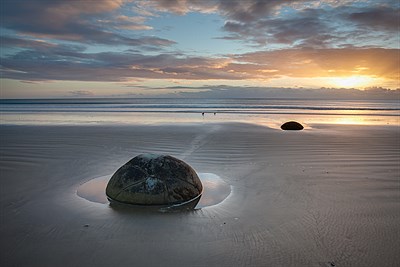
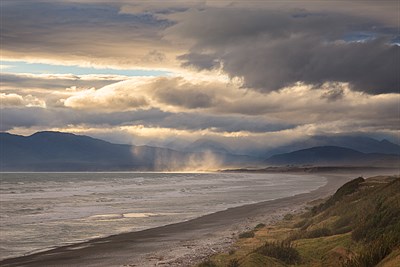
Fiordland
Fiordland National Park is usually the ultimate experience during the visit to New Zealand. It is located in the southwest of the South Island and it is the wildest and wettest part of the country. Mainly due to the rains and difficult terrain the area is uninhabited. It's an amazing feeling unfeasible anywhere else: you walk along the narrow path, and you know that in the area of tens to hundreds of kilometres around you there is no other infrastructure. So lush forests occur only on the west coast of Canada and USA. I had to register for trekking several weeks prior to arrival because the day limitations are hopelessly full otherwise. I absolve recently opened Kepler Trek as the first. It is a route about sixty kilometres long, divided into three stages, which eventually crosses all vegetation zones of the national park. During the first kilometre, I get a shock. The first walk through the rainforest makes me stop every ten metres and stare at the incredibly overgrown vegetation. I meet good teammates in the first camp: Israeli guy a with a post-traumatic syndrome, totally burned Japanese woman and accursed French poet. We understand each other well, so we stay together for some time.
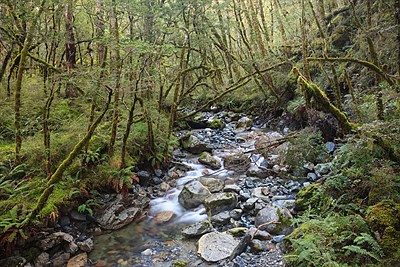

I set out solo to the famous Milford Sound, where the mountains climb from sea level a mile. I got lucky with the weather, and I experience fjord during 24 hours in both grim and sunny atmosphere. The place is very photogenic, all day I walk around, and in the evening and morning, I got quite busy photographing. I accommodate after a longer period in a local hostel, I take a warm shower and tell the girl in the room, how pleasant it is to have a shower after a week. She replies that one week was also her estimate when I entered the room. This concludes our conversation.
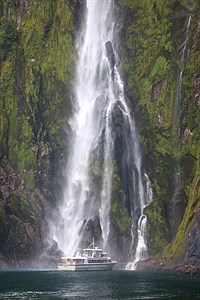
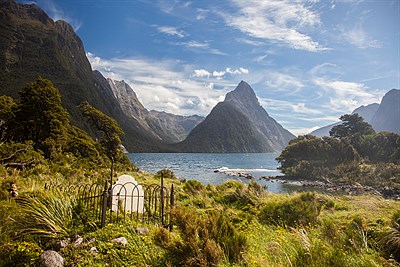
On the way back from the fjord I stop for photographing on the hill called Key Summit, which offers a panoramic view of the Fiordland mountains. The views are truly beautiful, and no one is there, but the light conditions are bad. To arrange a better composition I climb into the pool without shoes, but my legs got stuck so much that I have a problem getting out of the water. About ten minutes after sunset, I meet a tiny owl sitting on a tree just a few metres ahead. It waits patiently until I completely setup my camera, shoot it from a distance smaller than 50 centimetres and only then it flies away. Respect!

I get to the last of the Great Walks - famous Routeburn Trek. Estimated time for it is three days, but in a case of good weather, you can handle it in a single day. Rented car becomes a handicap since the trek ends at another road than it starts and it's necessary to go some 300 km by road to get back. Trek provides to its visitors all the vegetation zones south of New Zealand. Views from the trails are charming, but it is for me rather disappointing. First, it does not surpass the superlatives that accompany him in advance, and secondly, I already have made too much trekking probably. Because I do not want to spend time tracking back, I turn back before the end of the march and converge back to the car. From this moment I reset my priorities from tramping to photography.

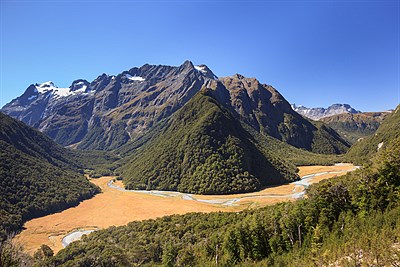
Otago and Wanaka
After the eastern, southern and western coast I have to explore the centre of the island. It lies in the rain shadow of the Southern Alps, and everything there is drier, sometimes almost parched. With friends, we meet in the town of Wanaka and go to Mount Cook National Park. Mount Cook is the highest peak in the country, and the mountain is famous for the fact that Sir Edmund Hillary undertook training for Everest right there. We follow the road along Lake Pukaki with azure blue water for several tens of kilometres. We arrive at the National Park and start climbing to Muller Hut. After a few minutes, it starts to rain so much, that I turn back to my car, I have a cold and don't want to risk too much. However, the rain stops after a few hours, and I decide to undertake a night climb to the hut, to see the sunrise from the top of the mountains. All tourists at the hut are completely decimated after the ascent of the previous day in extreme weather, and I'm the only one able to move no matter I'm sick.
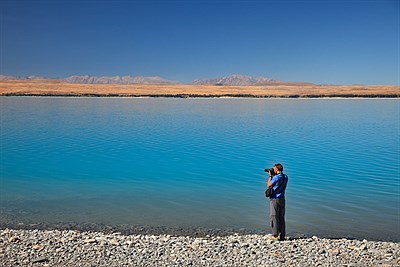
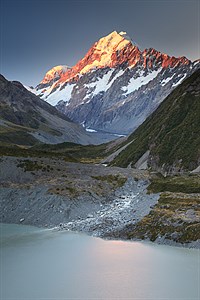
The last common expedition with friends leads to Mount Aspiring National Park. We walk through the Alpine valley below the second highest mountain in the country. We want to sleep in a hut on the mountainside, but we meet ranger, which warns us of the arrival of the cyclone and encourages us to get out of the valley because the road back will be impassable for a few days. I say goodbye to my friends at Lake Wanaka. Three roads lead from here, everyone chooses one. I surrender to explore the northern part of the West Coast.
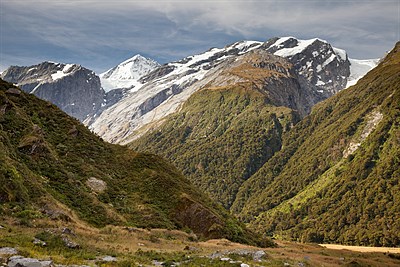
West coast
Now comes the reported cyclone. At first, it rains a lot, then it rains a lot more, but only after several hours, it really starts to rain heavily. Then the rain continually escalates, and eventually, it starts to rain so much that it's unlikely that it could even rain more. In the final stage, it turns out that it can. It is absolutely impossible to drive, so I spend the whole day sitting in the car in the parking lot and wonder what I'll do when I need to pee. Fortunately, the intense rain stops and turns to the usual, almost constant shower.
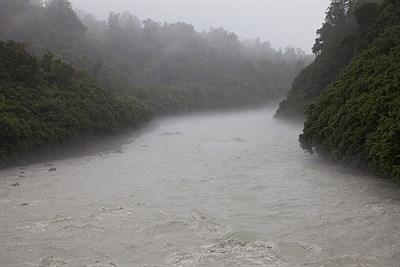
I pass around two glaciers, which are unique because they go down in the rain forest zone, but otherwise, they're not especially interesting. At night, I walk along a trail in the woods, from which you can see thousands of luminous points. It is an endemic species of phosphorescent worm called Glowworm. I try to shoot, but it's almost useless job in the dark. In the morning, I try to catch the light at Lake Matheson, which reflects Mount Cook, and I get better luck.
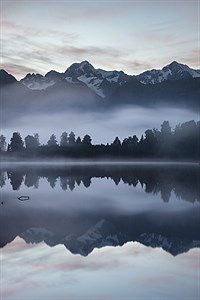
The last goal on the West Coast is a place called Pancake Rocks with beautiful cliffs and blowholes. These are oddly shaped holes in the cliff, where under certain circumstances the wave explodes and jumps out of the sea high into the air. Indeed, it happens from time to time, that the sea spray is high above my head, and I stand perhaps twenty metres above the sea level. The place is truly photogenic, and I stay there in the evening and the following morning. We exchange contacts with the French photographer and his admirer because we realize that we have almost identical itineraries and want to compare our results at home.
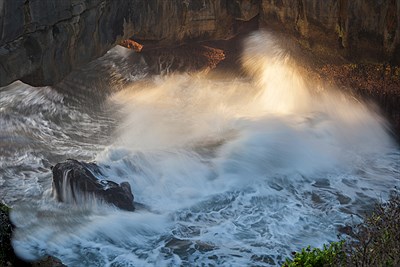
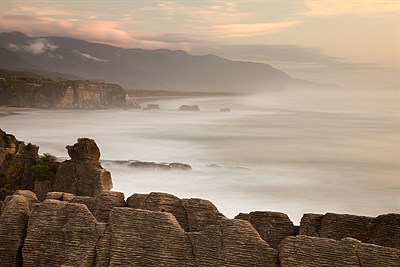
I cross the Southern Alps back to the eastern part of the island through Arthur's Pass. My batteries run out of power because I did not have any accommodation for a long time. In the pass, thus, I walk into a local coffee shop, and I order probably the most expensive espresso in my life, and I ask to waitress to plug in my recharger. The manager of the team comes in a while and tells me that espresso for recharging is too little and that I have to order food for at least 20 dollars. I am so shocked that my first humorous response to this situation comes to my mind the next day in the mountains. When I later tell this story to someone, he replies that it is symptomatic of the development of New Zealand society in the last decades. I get lost on the trail in the mountains, but it turns out that I get lucky, and I arrive at a magical place with a hut in the lowest price category, i.e. free of charge. At night, a terrible noise wakes me up. After a few minutes, one of the longest in my life, I discover that two parrots Kea came to mess around with me and periodically jump on a tin roof. Kea is very intelligent and apparently, the birds have to play with something constantly to not to get bored to death. The local government has even funded a project to develop a smartphone operated by neb to minimize the damage those birds cause each year to the infrastructure of this frustrated country.
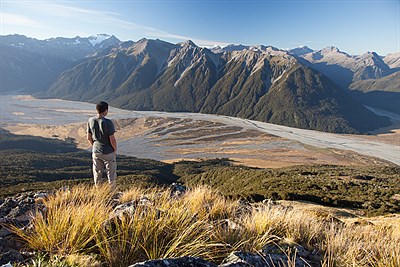
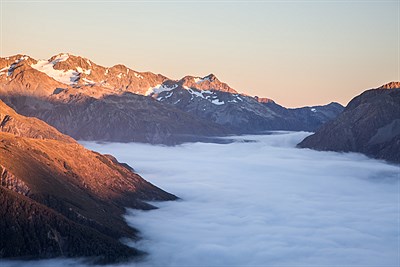
I return the car in Christchurch on the agreed day. Now I have to hitchhike across both islands back to Auckland. The manager of the car rental company is friendly and takes me to the highway to the north end of the city. I sleep in the town of Kaikoura, which is visited mainly due to whale watching. After a very long time again, I have accommodation, and I'm lucky to find a hostel with sauna. Sauna is better than whales convince I myself trying to save some money. The next day I wait for the ferry to the North Island. After more than a month of wandering around the beautiful South Island, I do not want to leave. The southern half of Zealand says goodbye by a stylish sunset.
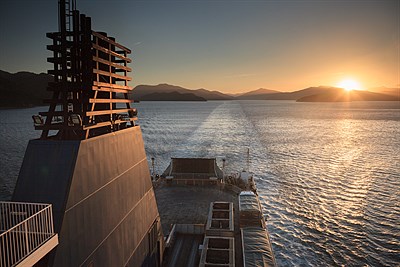
Back to north
On the north island, I plan just one stop because I'm already limited by time. It is a sacred mountain of Maori people, the Taranaki volcano. It rises symmetrically from the lowland up to 2,700 metres and climbing is a terrible labour. I reject the idea of conquering the peak at the cottage at an altitude of 2000 metres, where I arrive almost dead - who's ever tried to climb on a pile of sand, and he knows what I mean. Besides me, the only guests are an elderly couple, who together wander for more than a year over the country and still go very well together and even laugh out loud at the other's jokes. Sunset and sunrise are monstrous. In the evening, volcano casts a shadow to the Tongariro massif, where I started my trip while in the morning there are on the contrary inverse clouds all around us. In the village below the volcano, Maori children sing traditional folk songs. Although I do not understand a word, I applaud frenetically and hope that the lyrics are not about murdering white faces, including tourists, and returning to the good old days.

Hitchhiking to Auckland works fine, people invite me to eat and drink, a nice man even takes me to the car when I'm lying on the road and relax, and then waits for me in front of the supermarket. Petrol station employee takes me a few kilometres further because he thinks that where I stay is not a good place for hitchhiking. New Zealand says goodbye in the best possible way. The last day I spend in the capital, and it is a shock after nearly six weeks in the wilderness. I sleep in the house of one girl from Bohemia, to whom I have had contact from home. She is a excellent observer and, unfortunately, only the last evening I get to know so many interesting facts about the country. It remains to survive the 56-hour flight with four transfers, and one is from the other end of the world back home.
More in gallery





